Coherence Time Evaluation in Indoor Optical Wireless Communication Channels
Abstract
:1. Introduction
2. Theory
2.1. Transceiver Distance and Device Orientation
2.2. Coherence Time
3. Experimental Setup
3.1. Light Emitting Diode (LED)
3.2. Measurements
3.3. Scenarios
- Walking: The main expected reason for channel changes is a change in transceiver separation distance. The experimental scenario realization is presented in Figure 3a. In this scenario, the user walks a distance of approximately 2 m, in a horizontal plane below the signal source. The horizontal displacement is shifted by 30 cm away from the signal source between subsequent measurement sets, with ten measurements in each set, making a total of 50 measurements.
- Standing up/sitting down: During these operations a receiver experiences rapid distance, orientation, and shadowing changes at once. In this scenario, standing up and sitting down are performed at two different orientations and five different horizontal positions spaced 30 cm from one another, with each measurement performed twice (Figure 3b), making a total of 20 measurements for each operation.
- Rotating: In this case, the main reasons for channel changes are orientation and shadowing. In this scenario the measurements included rotations of 360, twice, with five different horizontal positions spaced 30 cm from one another (Figure 3c). The measurements were repeated for both standing, with approximately 120 cm vertical distance between the lamp and the receiver, and sitting on a rotating chair, with approximately 165 cm vertical distance between the lamp and the receiver, making a total of 40 measurements.
4. Experimental Results
4.1. Illustrative Result
4.2. Characterization
- (a)
- maximum change, i.e., difference between highest and lowest value;
- (b)
- standard deviation;
- (c)
- peak Fourier transform amplitude of non-DC component; and
- (d)
- frequency of the peak Fourier transform amplitude of non-DC component.
5. Discussion
5.1. Characterization
5.2. Fast and Slow Fading
5.3. Threshold Values
6. Summary and Conclusions
Funding
Acknowledgments
Conflicts of Interest
Appendix A. Local to Global Coordinate System Transformation
Appendix A.1. Linear Acceleration
Appendix A.2. Orientation
Appendix A.3. Angular Acceleration
References
- Rappaport, T.S. Wireless Communications; Prentice Hall: Upper Saddle River, NJ, USA, 2001. [Google Scholar]
- Barry, J.; Kahn, J.; Krause, W.; Lee, E.; Messerschmitt, D. Simulation of multipath impulse response for indoor wireless optical channels. IEEE J. Sel. Areas Commun. 1993, 11, 367–379. [Google Scholar] [CrossRef] [Green Version]
- Carruthers, J.B.; Carroll, S.M. Statistical impulse response models for indoor optical wireless channels. Int. J. Commun. Syst. 2005, 18, 267–284. [Google Scholar] [CrossRef]
- Lee, K.; Park, H.; Barry, J.R. Indoor Channel Characteristics for Visible Light Communications. IEEE Commun. Lett. 2011, 15, 217–219. [Google Scholar] [CrossRef]
- Long, S.; Khalighi, M.A.; Wolf, M.; Bourennane, S.; Ghassemlooy, Z. Channel characterization for indoor visible light communications. In Proceedings of the 3rd International Workshop in Optical Wireless Communications (IWOW), Funchal, Portugal, 10 November 2014. [Google Scholar] [CrossRef]
- Bykhovsky, D. Coherence distance in indoor optical wireless communication channels. Opt. Lett. 2018, 43, 2248–2251. [Google Scholar] [CrossRef]
- Bas, C.L.; Sahuguede, S.; Julien-Vergonjanne, A.; Behlouli, A.; Combeau, P.; Aveneau, L. Impact of receiver orientation and position on Visible Light Communication link performance. In Proceedings of the 4th International Workshop on Optical Wireless Communications (IWOW), Istanbul, Turkey, 7–8 September 2015. [Google Scholar] [CrossRef]
- Wang, J.Y.; Li, Q.L.; Zhu, J.X.; Wang, Y. Impact of receiver’s tilted angle on channel capacity in VLCs. Electron. Lett. 2017, 53, 421–423. [Google Scholar] [CrossRef]
- Eroğlu, Y.S.; Yapici, Y.; Güvenc, I. Impact of Random Receiver Orientation on Visible Light Communications Channel. IEEE Trans. Commun. 2019, 67, 1313–1325. [Google Scholar] [CrossRef] [Green Version]
- Soltani, M.D.; Purwita, A.A.; Zeng, Z.; Haas, H.; Safari, M. Modeling the Random Orientation of Mobile Devices: Measurement, Analysis and LiFi Use Case. IEEE Trans. Commun. 2019, 67, 2157–2172. [Google Scholar] [CrossRef] [Green Version]
- Purwita, A.A.; Soltani, M.D.; Safari, M.; Haas, H. Terminal Orientation in OFDM-Based LiFi Systems. IEEE Trans. Wirel. Commun. 2019, 18, 4003–4016. [Google Scholar] [CrossRef]
- Arfaoui, M.A.; Soltani, M.D.; Tavakkolnia, I.; Ghrayeb, A.; Assi, C.; Safari, M.; Haas, H. Measurements-Based Channel Models for Indoor LiFi Systems. arXiv 2020, arXiv:2001.09596v1. [Google Scholar]
- Gupta, A.; Garg, P. Statistics of SNR for an Indoor VLC System and Its Applications in System Performance. IEEE Commun. Lett. 2018, 22, 1898–1901. [Google Scholar] [CrossRef]
- Jivkova, S.; Kavehrad, M. Shadowing and blockage in indoor optical wireless communications. In Proceedings of the GLOBECOM’03 Global Telecommunications Conference (IEEE), San Francisco, CA, USA, 1–5 December 2003; pp. 3269–3273. [Google Scholar] [CrossRef]
- Komine, T.; Nakagawa, M. A study of shadowing on indoor visible-light wireless communication utilizing plural white LED lightings. In Proceedings of the 1st International Symposium on Wireless Communication Systems, Port-Louis, Mauritius, 20–22 September 2004. [Google Scholar] [CrossRef]
- Bas, C.L.; Sahuguede, S.; Julien-Vergonjanne, A.; Behlouli, A.; Combeau, P.; Aveneau, L. Human body impact on mobile visible light communication link. In Proceedings of the 10th International Symposium on Communication Systems, Networks and Digital Signal Processing (CSNDSP), Prague, Czech Republic, 20–22 July 2016. [Google Scholar] [CrossRef] [Green Version]
- Chvojka, P.; Zvanovec, S.; Haigh, P.A.; Ghassemlooy, Z. Channel Characteristics of Visible Light Communications Within Dynamic Indoor Environment. J. Light. Technol. 2015, 33, 1719–1725. [Google Scholar] [CrossRef]
- Miramirkhani, F.; Narmanlioglu, O.; Uysal, M.; Panayirci, E. A Mobile Channel Model for VLC and Application to Adaptive System Design. IEEE Commun. Lett. 2017, 21, 1035–1038. [Google Scholar] [CrossRef]
- Bykhovsky, D.; Arnon, S. Multiple Access Resource Allocation in Visible Light Communication Systems. J. Light. Technol. 2014, 32, 1594–1600. [Google Scholar] [CrossRef]
- Armstrong, J. OFDM for Optical Communications. J. Light. Technol. 2009, 27, 189–204. [Google Scholar] [CrossRef]
- Komine, T.; Nakagawa, M. Fundamental analysis for visible-light communication system using LED lights. IEEE Trans. Consum. Electron. 2004, 50, 100–107. [Google Scholar] [CrossRef]
- Gardner, W.A. A unifying view of coherence in signal processing. Signal Process. 1992, 29, 113–140. [Google Scholar] [CrossRef]
- Bykhovsky, D.; Lyandres, V. On the numerical generation of positive-axis-defined distributions with an exponential autocorrelation function. Digit. Signal Process. 2018, 77, 43–47. [Google Scholar] [CrossRef]
- Kahn, J.; Barry, J. Wireless infrared communications. Proc. IEEE 1997, 85, 265–298. [Google Scholar] [CrossRef] [Green Version]
- Demirkol, I.; Camps-Mur, D.; Paradells, J.; Combalia, M.; Popoola, W.; Haas, H. Powering the Internet of Things through Light Communication. IEEE Commun. Mag. 2019, 57, 107–113. [Google Scholar] [CrossRef] [Green Version]
- Magno, M.; Sigrist, L.; Gomez, A.; Cavigelli, L.; Libri, A.; Popovici, E.; Benini, L. SmarTEG: An Autonomous Wireless Sensor Node for High Accuracy Accelerometer-Based Monitoring. Sensors 2019, 19, 2747. [Google Scholar] [CrossRef] [Green Version]
- Chellam, J.; Jeyachitra, R.K. Energy-efficient bi-directional visible light communication using thin-film corner cube retroreflector for self-sustainable IoT. IET Optoelectron. 2020, 14, 223–233. [Google Scholar] [CrossRef]
- Bykhovsky, D. Symbol error rate of soft-decision multiple pulse position modulation over turbulent channels. Appl. Opt. 2019, 58, 1193. [Google Scholar] [CrossRef] [PubMed]
- Bergel, I.; Benedetto, S. The effective coherence time of common channel models. In Proceedings of the 2010 IEEE 11th International Workshop on Signal Processing Advances in Wireless Communications (SPAWC), Marrakech, Morocco, 20–23 June 2010. [Google Scholar] [CrossRef]
- Devices and Sensors Working Group. DeviceOrientation Event Specification. Available online: https://www.w3.org/TR/2019/WD-orientation-event-20190416/ (accessed on 31 August 2020).

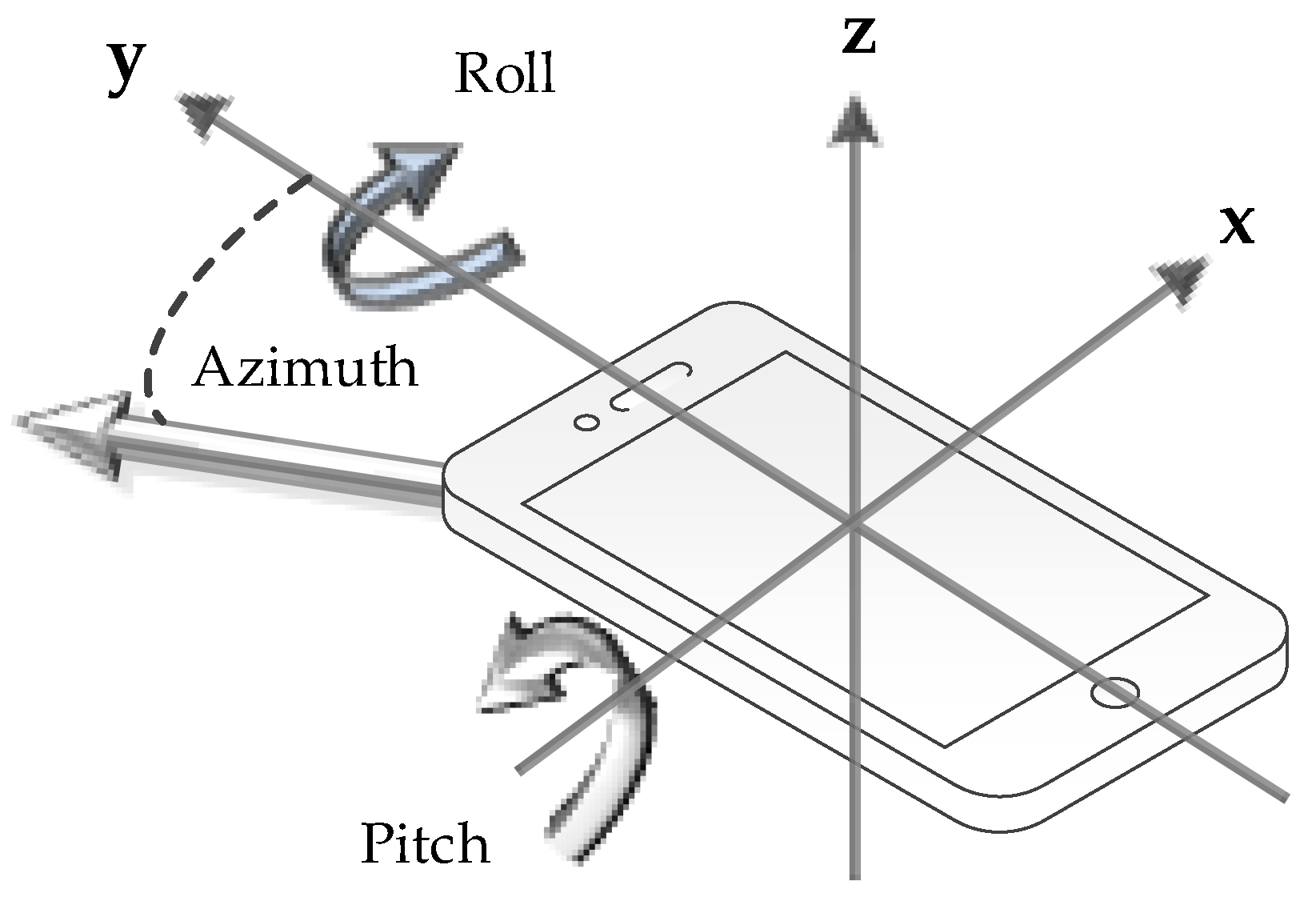


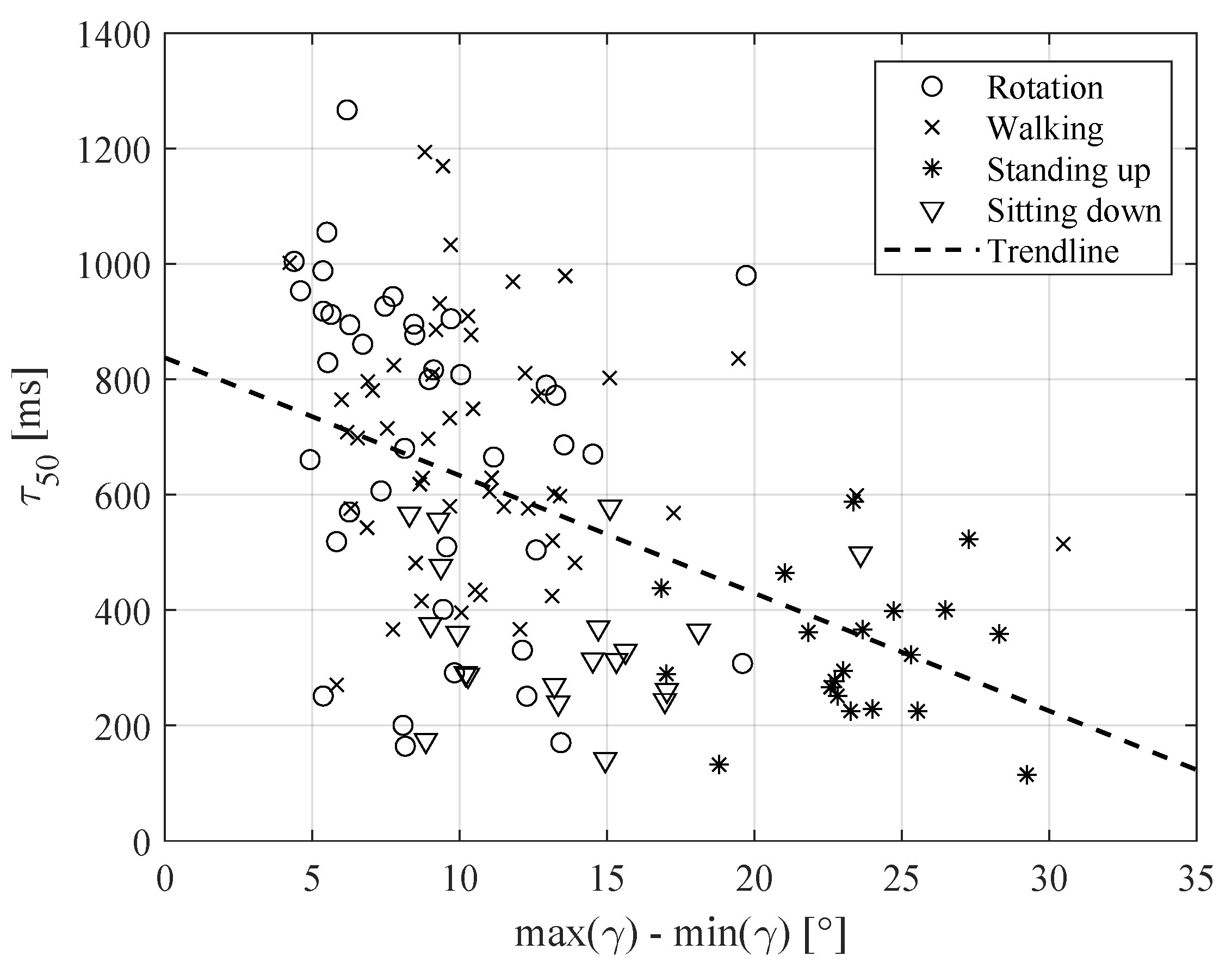
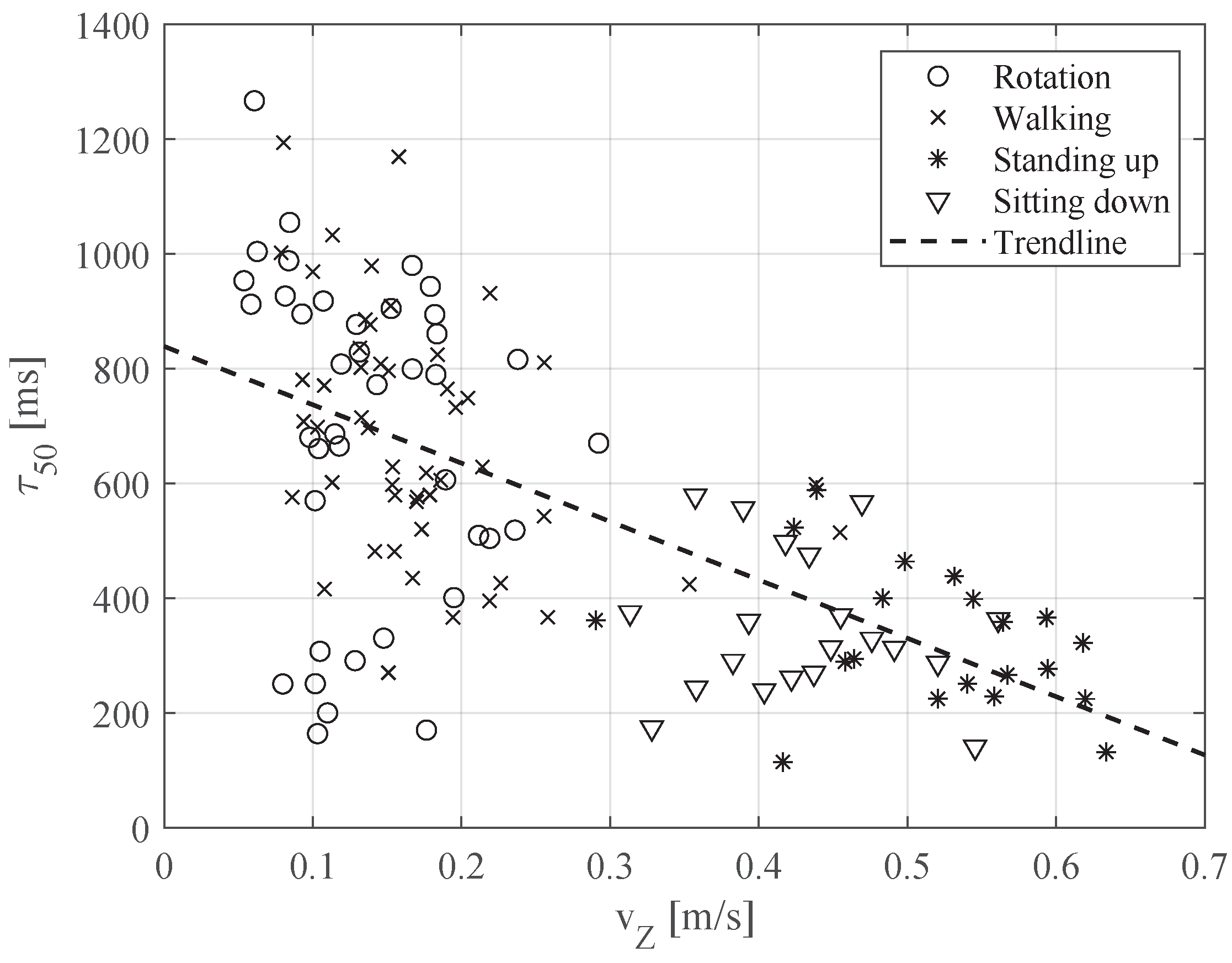
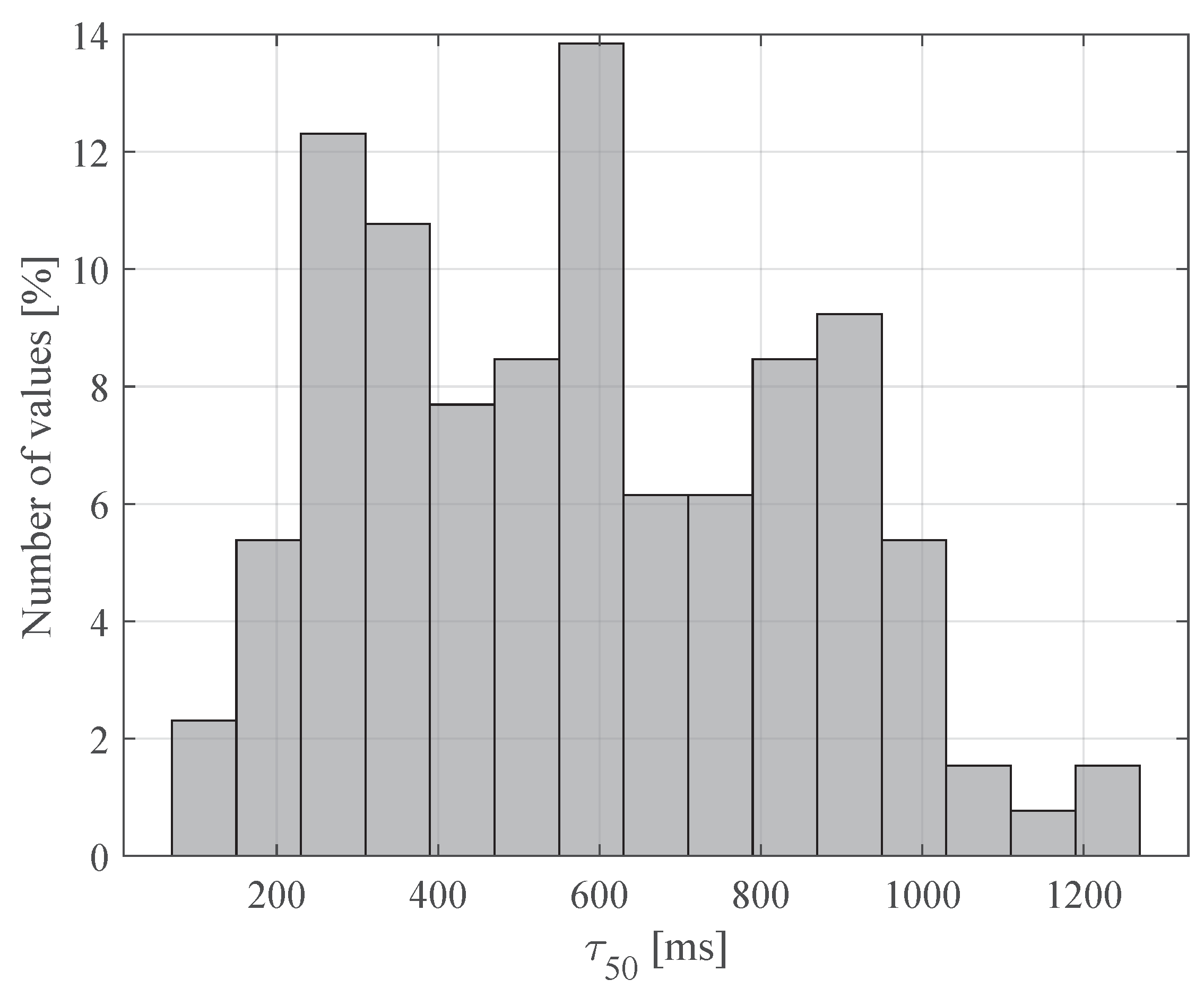
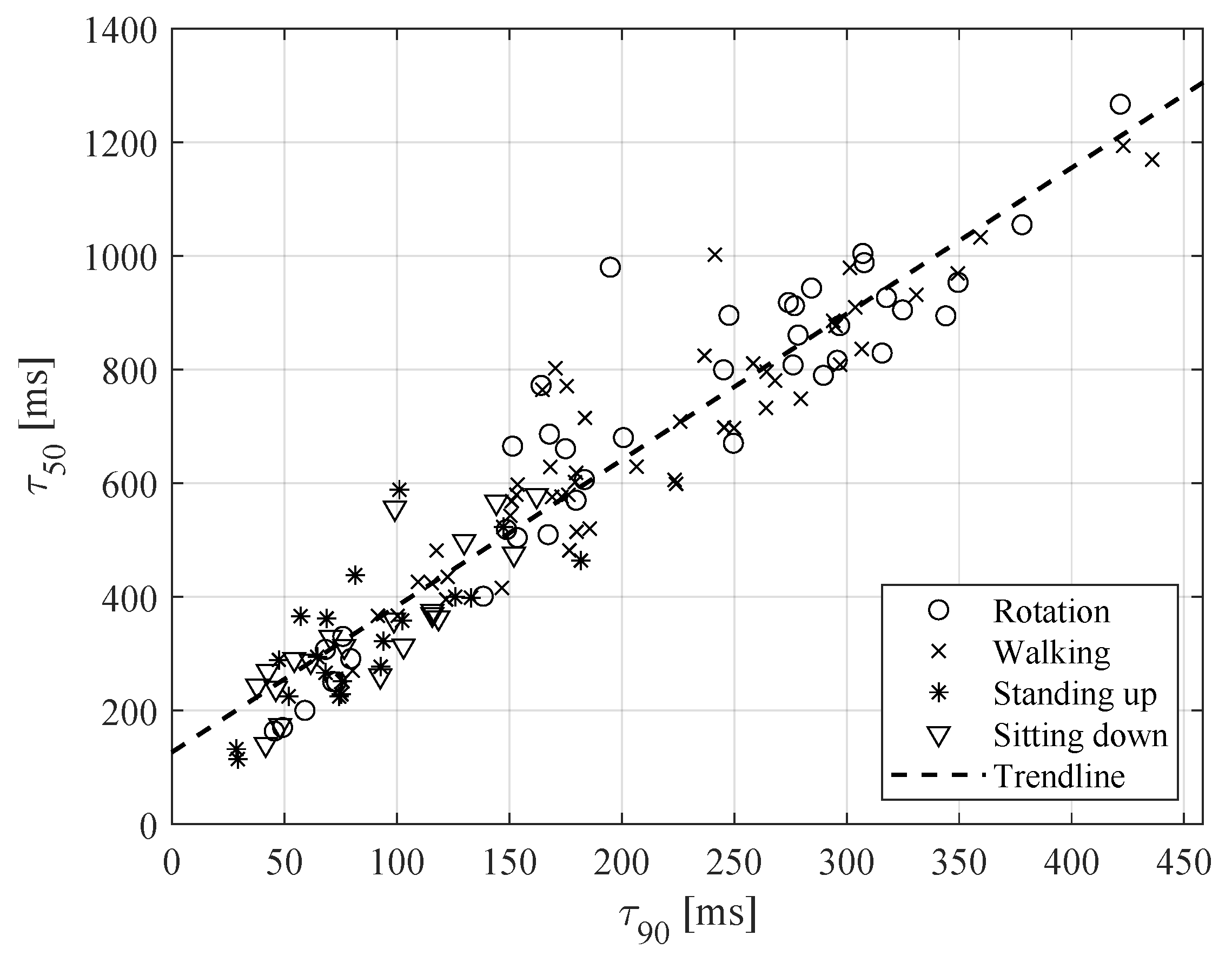
| Parameter | Value |
|---|---|
| Room height | 2.4 m |
| Room width | 4 m |
| Room length | 3.5 m |
| Sampling frequency | 100 Hz |
| Sensor measurements | acceleration, orientation, angular velocity |
| Walking distance | 2 m |
| Chair height | 53 cm |
| # | Measurement Type | Measurement | Note |
|---|---|---|---|
| 1 | Anglular position (orientation) | local azimuth | |
| 2 | local roll | ||
| 3 | local pitch | ||
| 4 | global polar | Equation (A3) | |
| 5 | global azimuth | Equation (A4) | |
| 6 | Linear Acceleration | local X | |
| 7 | local Y | ||
| 8 | local Z | ||
| 9 | global X | Equation (A1) | |
| 10 | global Y | ||
| 11 | global Z | ||
| 12 | norm | with g | |
| 13 | norm | without g | |
| 14 | Angular Velocity | local azimuth | |
| 15 | local roll | ||
| 16 | local pitch | ||
| 17 | global polar | Equation (A5) | |
| 18 | global azimuth | Equation (A6) |
| Parameter | Metric | |||
|---|---|---|---|---|
| (a) | (b) | (c) | (d) | |
| #1 | 0.24 | 0.25 | 0.28 | |
| #2 | −0.48 | −0.46 | −0.39 | |
| #3 | −0.26 | |||
| #4 | −0.47 | −0.47 | −0.40 | |
| #5 | ||||
| #6 | 0.39 | |||
| #7 | −0.49 | −0.54 | −0.49 | |
| #8 | −0.55 | −0.59 | −0.63 | 0.31 |
| #9 | ||||
| #10 | ||||
| #11 | −0.56 | −0.57 | −0.60 | 0.36 |
| #12 | −0.56 | −0.57 | −0.60 | 0.29 |
| #13 | −0.53 | −0.58 | −0.54 | |
| #14 | −0.43 | −0.50 | −0.49 | 0.28 |
| #15 | ||||
| #16 | 0.23 | |||
| #17 | ||||
| #18 | 0.29 | 0.23 | ||
© 2020 by the author. Licensee MDPI, Basel, Switzerland. This article is an open access article distributed under the terms and conditions of the Creative Commons Attribution (CC BY) license (http://creativecommons.org/licenses/by/4.0/).
Share and Cite
Bykhovsky, D. Coherence Time Evaluation in Indoor Optical Wireless Communication Channels. Sensors 2020, 20, 5067. https://doi.org/10.3390/s20185067
Bykhovsky D. Coherence Time Evaluation in Indoor Optical Wireless Communication Channels. Sensors. 2020; 20(18):5067. https://doi.org/10.3390/s20185067
Chicago/Turabian StyleBykhovsky, Dima. 2020. "Coherence Time Evaluation in Indoor Optical Wireless Communication Channels" Sensors 20, no. 18: 5067. https://doi.org/10.3390/s20185067





